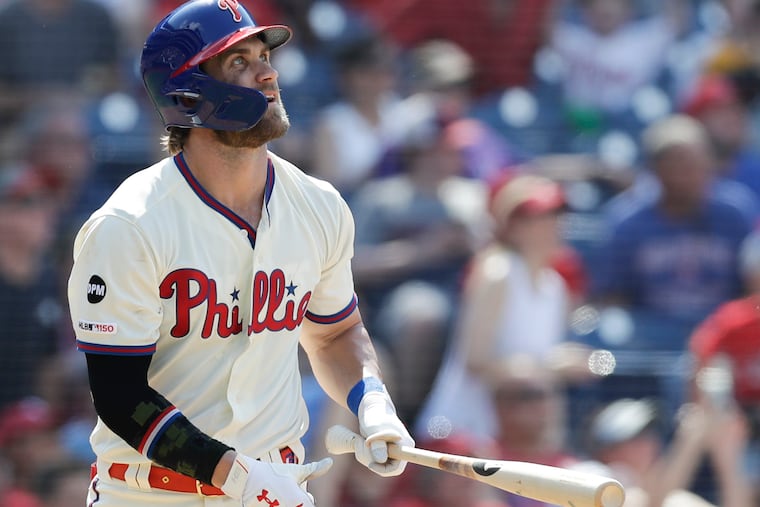In the midst of another odd season, Phillies’ Bryce Harper is raking again. Who knows what comes next? | David Murphy
Bryce Harper's statistics have always had an unpredictable variance to them, but what do his past seasons tell us about what to expect for the rest of the year?

This is not really a good news/bad news sort of thing. From an ends-based perspective, it’s all good news regarding Bryce Harper. Just three weeks removed from one of the worst 33-game stretches of his career, Harper’s .835 OPS entering Friday’s game puts him in the top 37 percent of qualified major-league hitters. While that probably wasn’t the Phillies’ best-case scenario when they made Harper a member of baseball’s 0.1 percent economic bracket, it’s still 131 points better than they got out of their three-hole hitters last season. It also happens to be better than the marks Harper has posted in three of his eight major-league seasons.
The issue here isn’t one of decline. Rather, it’s that of a player whose production has been remarkably variable throughout his career, considering his six All-Star appearances and 2015 National League MVP award. Take that MVP season, which saw him hit at an all-time-great level, with a .330 batting average and a .460 on-base percentage and a .649 slugging percentage and 42 home runs. The following year, he was remarkably close to average, with an OPS that dropped nearly 300 points, to .814. Then, in 2017, HOF Bryce reemerged: a 1.008 OPS, a .413 on-base percentage, and 29 home runs.
1.109 to .814 to .1.008.
You don’t need to know what the numbers mean to know that they indicate an uneven ride.
For those of us watching Harper on a daily basis for the first time, it was surprising to see just how out of sync he looked during that aforementioned 33-game stretch, when he hit just .195 with a .659 OPS and struck out in 47 of his 123 at-bats. But slumps are nothing new for the 26-year-old slugger. In fact, he endured similar stretches in four of his previous six seasons, the lone exceptions those dominant campaigns in 2015 and 2017 (his OPS was below 1.000 for exactly five days in the latter of the two).
In each of those seasons, the pattern was the same. Once he busted out of the slump, he was out of it for good, posting an OPS over the rest of the season that was equal to or greater than his season OPS. There’s a bit of circularity in there, of course. His season OPS was what it was in part because of those remaining games. But consider last season, when he broke out of a May-June slump and posted a .944 OPS in his final 90 games to lift his season OPS to .889.
There’s plenty of reason to think that the Harper we’ve seen over the last 19 games is the one we’ll see the rest of the season. That’s a guy who hit .308 with a .914 OPS and four home runs in 83 plate appearances (that’s a pace of 35 home runs per 162 games). Plenty good enough for a three-hole hitter on a playoff team.
Still, there are a couple of interesting things to note about this recent stretch that suggest Harper is still a player who is the proverbial box of chocolates. First and foremost, he has drawn just four walks in those 83 plate appearances, well below his career-average rate, which would suggest he should have in the neighborhood of 12. At the same time, the numbers suggest that many of those missing walks have turned into extra-base hits: he has 13, while his career rate would put him at eight.
Those two facts make further sense when you consider that Harper is still striking out well north of his career average. On the season, he has whiffed in 29.4 percent of his plate appearances, which would eclipse his career high by 3.1 percentage points. That’s a trend that has been unfolding over the last few seasons, when he has gone from averaging a strikeout every 4.2 at-bats in 2017 to one every 3.3 last year to one every 2.9 this season. Even in this most-recent stretch, he has struck out in about 26 percent of his plate appearances.
Even when you factor in the reality that hitters in general are striking out more — in the NL, batters averaged a K every 4.1 at-bats in 2017, 3.9 at-bats last year, and 3.8 at-bats this season — Harper has seen a significant increase in that area. And it is mostly attributable to him swinging and missing. He’s swinging at a similar number of pitches, he’s just making less contact. He has connected on what would be a career-low of 64.9 percent of his swings, nearly 8 percentage points below his career mark. (Rhys Hoskins, by contrast, is connecting on 76.4 percent of his swings, which isn’t far off from his rate in his first two big-league seasons.)
There are lots of different plot lines to monitor with this Phillies team, from the situation in center field in the wake of Andrew McCutchen’s injury to a bullpen that has oxygen masks hanging from the ceiling. From an individual standpoint, count the balance of Harper’s season as one of the most interesting. His MVP season saw him hit 24 home runs with a 1.071 OPS after June 5. We’ve seen flashes of that player, and there’s something exciting about a guy who has been this hard to predict.